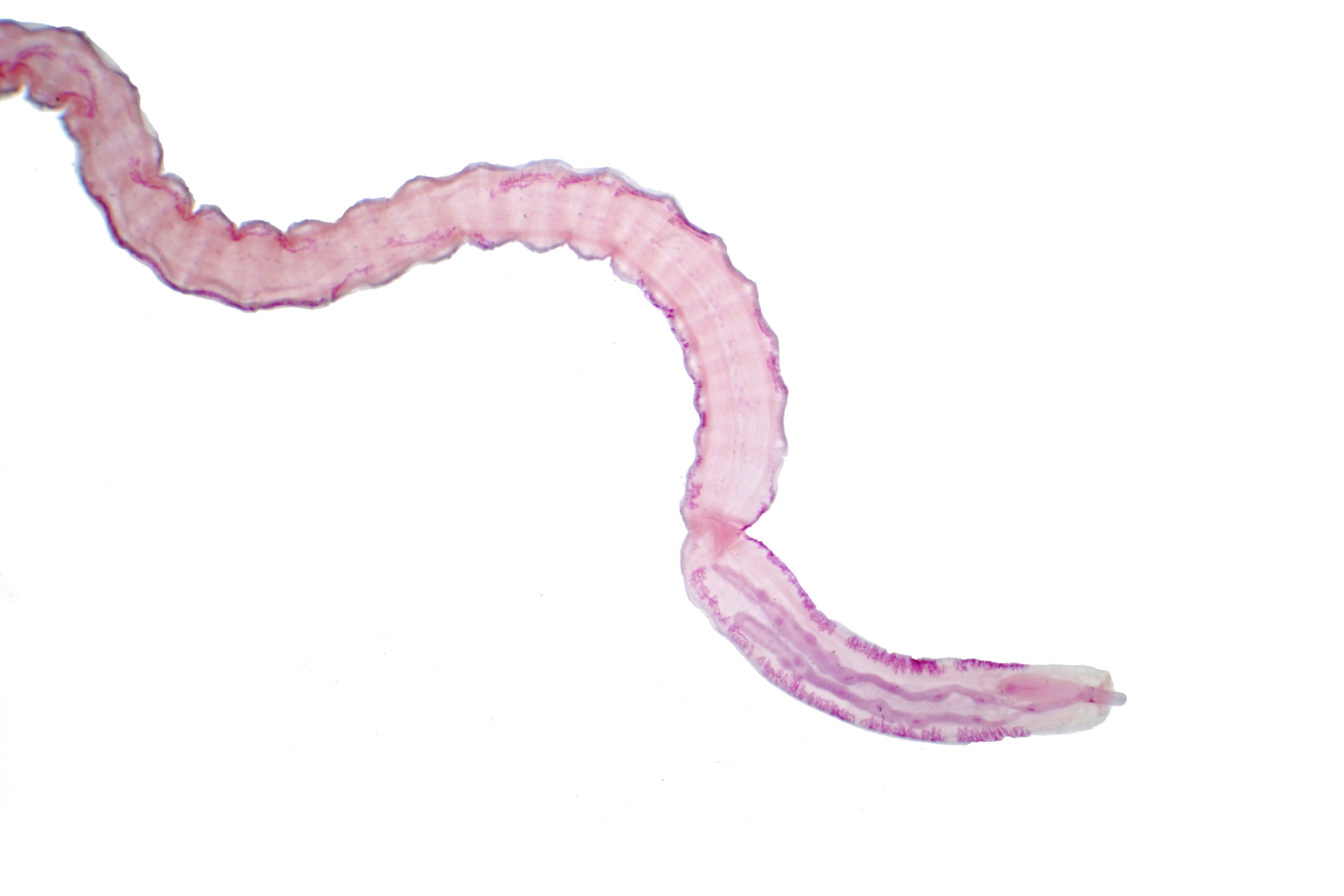Written by: Bria Osborne, OVC 2026
Edited by: Dr. Paisley Canning
A parasite is a tiny creature (usually a worm or a mite) that lives on or in your animal. Different species of animals are susceptible to different types of parasites. Parasites can pose a health risk to your Alpacas as they can carry diseases, cause anemia, gastrointestinal damage, and death in severe cases.
Many animals will have some sort of parasite load in their bodies and that is normal. When the animals’ parasitic load gets too high, or they have particularly dangerous parasites, is when intervention should be considered. The severity of damage caused by parasites is dependent on the length of the infection, immune status of the animal, the type of parasite, the number of parasites in the animal, and genetic predisposition of the animal.
Additionally, animals within the same herd, living in the same space, eating the same things, can have varying levels of parasites in their bodies. This is because each animal has varying levels of immunity towards certain parasites.
Types of Internal Parasites in Alpacas
It is very difficult to tell what type of parasites your alpacas may be dealing with without veterinary intervention and fecal testing. We don’t expect you to be able to diagnose any of the following parasites, but we have provided them so you can see that there are many different types of parasites and signs associated with them.
Meningeal Worm (figure 1)
- White tailed deer are the primary host, who pass on the worm to snails and slugs.
- When alpacas consume vegetation containing the snail/slug or their excrement, they become infected with the worm.
- Once ingested, the meningeal worm travels through the alpaca’s body and into the spinal cord and brain.
- Meningeal worm can cause an array of neurological signs including stiffness, head tilt, loss of coordination, paralysis, among other signs.
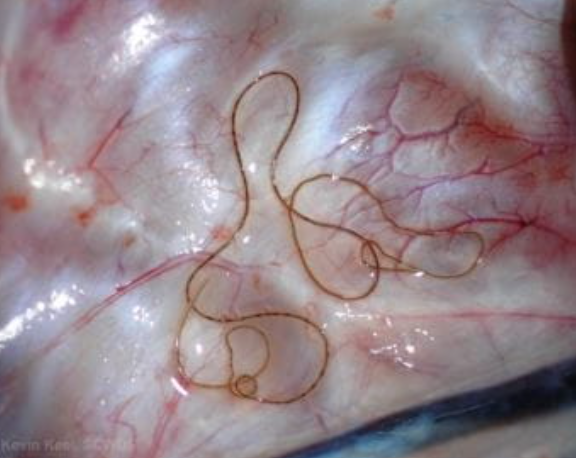
Photo credit: Dr. Kavin Keel
Figure 1: Above is a picture of a Meningeal Worm.
Whipworms (figure 2)
- Inhabit the large intestine.
- Eggs can survive in extreme temperatures for years
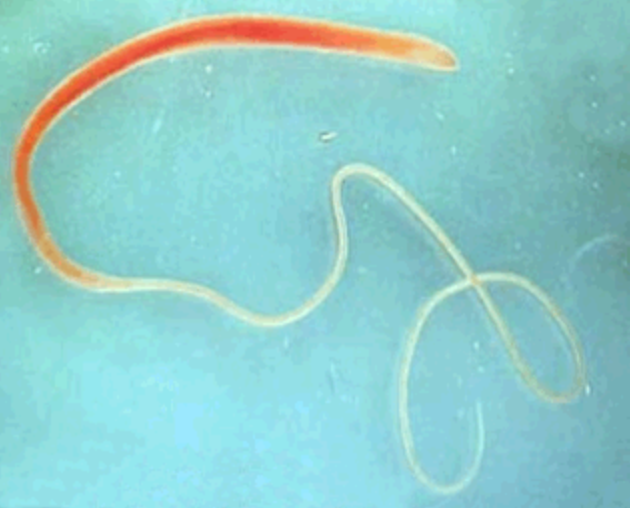
Photo credit: https://www.havenah.com/whipworms.pml
Figure 2: Above is a picture of a Whipworm.
Nematodirus (figure 3)
- Inhabit small intestine
- Make the alpaca more susceptible to ulcers
- A large Nematodirus infection may result in alpaca’s being “poor doers” overall and cause clumped stool
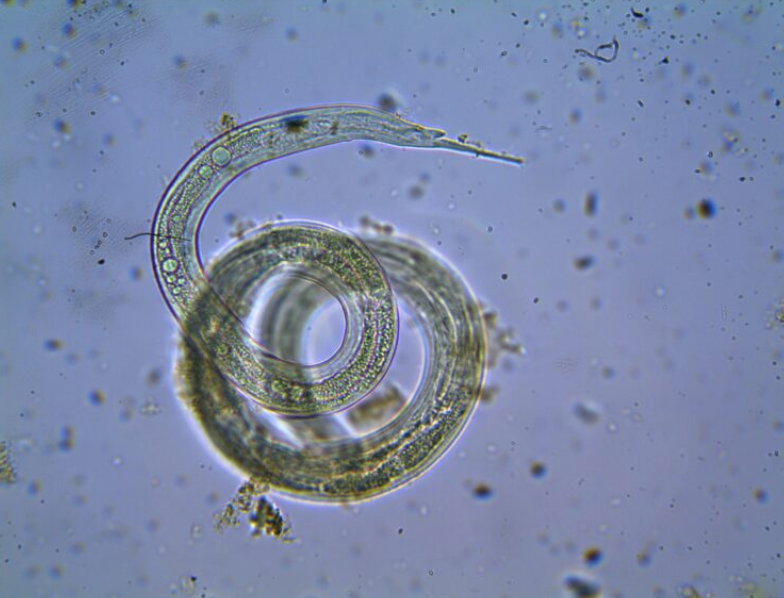
Photo credit: https://ridgewayresearch.co.uk/nematodirosis-in-lambs/
Figure 3: Above is a photo of a Nematodirus parasite
Barber’s Pole Worm (figure 4)
- Can quickly cause severe anemia, pale mucous membranes, weight loss, weakness, fecal clumping, or diarrhea.
- Larvae can become dormant over the winter and start causing issues in the spring.
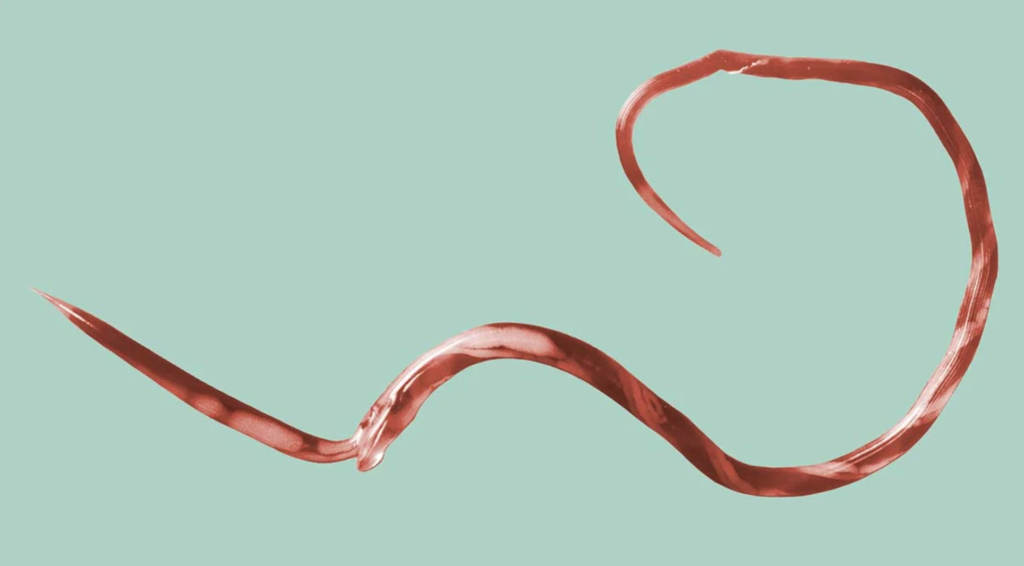
Photo credit: https://bri.sulross.edu/big-game/pronghorn-diseases-and-parasites/
Figure 4: Above is a photo of a barber’s pole worm
Tapeworms (figure 5)
- Appear in stool and looks like pieces of rice
- Heavy infestations can cause diarrhea and un-thriftiness
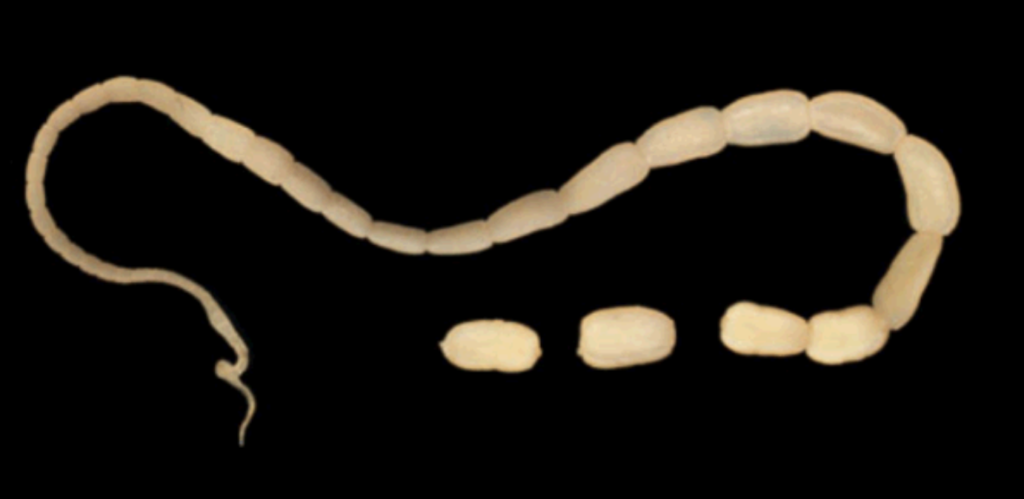
Photo credit: https://www.marvistavet.com/tapeworm.pml
Figure 5: Above is a photo of a tapeworm. Note how smaller segments break away from the larger worm.
Coccidia (figure 6)
Affects both young and adult alpacas.
Can cause weight loss, loss of appetite, lethargy, colic, diarrhea, and potentially sudden death.
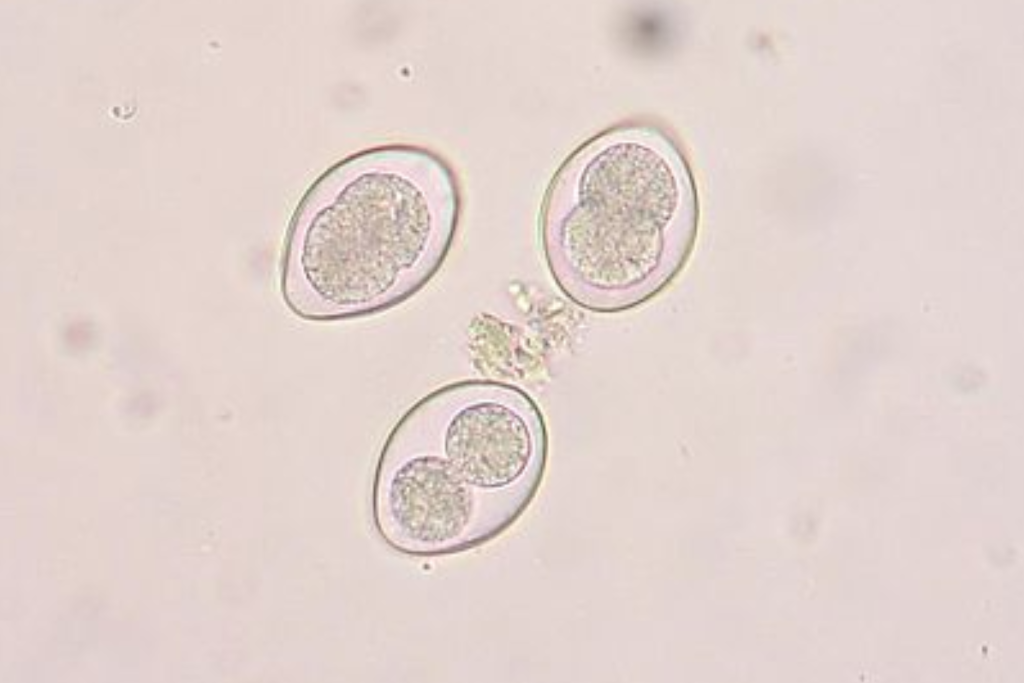
Photo credit: https://en.wikipedia.org/wiki/Coccidia
Figure 6: Above is a photo a Coccidia parasites
Cryptosporidium (Figure 7)
- Affects young Crias (1-3 months of age).
- Causes greenish, thin, and foul-smelling diarrhea.
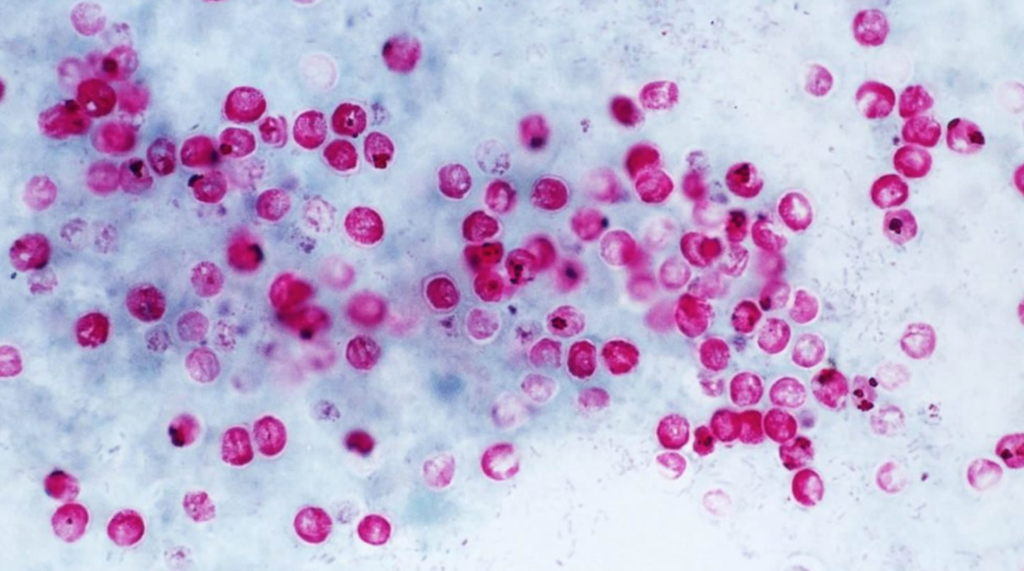
Photo credit: https://healthjade.com/cryptosporidium/
Figure 7: Above is a photo showing many cryptosporidium parasites.
Giardia (figure 8)
- Affects juvenile alpacas, alpacas that have left the property in recent past, and alpacas exposed to dirty water
- Also common in Crias 2 weeks -3 months as well as yearlings
- Can persist for years until the source and asymptomatic carriers are eliminated
- Causes pudding-like/ green stool, weight loss, and potentially death
- Wildlife such as deer and beavers can cause an outbreak
- Inadequate passive transfer, other diseases, stress, and inadequate nutrition predisposes an animal to infection
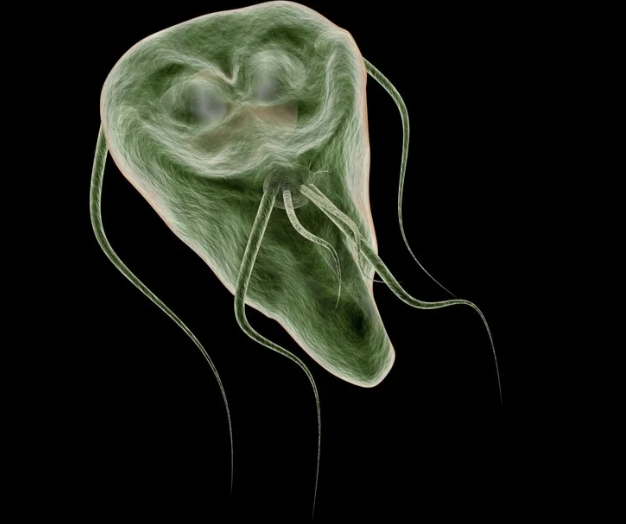
Photo credit: https://www.news-medical.net/health/Giardiasis-Intestinal-Infection.aspx
Figure 8: Above is a diagram demonstrating what a giardia parasite looks like.
How to prevent parasites?
Most parasites come from the environment so it can be very hard to prevent completely. The following are some recommendations for how to reduce parasites in Alpacas.
- Perform fecal tests on individual alpacas within a herd
- Be sure to collect right from their rectum as collecting from poop piled may not give an accurate representation of parasites within the herd or individuals
- Accurate fecal tests allow your vet to properly prescribe medications if needed
- Twenty percent of alpaca’s harbor 80% of the herds parasites
- Select for naturally resistant animals during breeding
- Find out what animals have the highest parasite loads (via fecal samples)
- Avoid overcrowding
- Remove manure often
- Remove poop piles daily, or every 3 days at most
- Use feeders that are slightly off the ground
- Most parasites are transferred by the “fecal-oral” route meaning that the animal must ingest poop to contract the parasite. Therefore, by raising the feeders slightly off the ground (but not too high – see our blog about choke in Alpacas for more information about feeder height) reduces the chance of your alpacas ingesting contaminated feces.
- Have good biosecurity practices
- Have good, sturdy fences to prevent wild animals (such as deer) from entering the pasture
- Make sure that visitors have clean shoes free of manure from other farms
- Maintain overall health
- Healthy animals are less likely to have large parasite burdens
- Staying up to date on vaccines, treating disease events, and providing adequate nutrition helps to promote optimal health
- For meningeal worms:
- Keep wild deer away from alpacas (do not set up wildlife feeders near them)
- Keep alpacas as far away as possible from bodies of water (I.e ponds, streams, and lakes)
- Monthly preventative ivermectin shots
How do I know if my alpaca has parasites?
There are a number of health parameters that are accessed by your veterinarian in order to determine if your Alpaca has internal parasites.
Some common physical parameters assessed include:
- Irregular stool
- Pale mucus membranes of gums and eyes
- Weight loss
Getting a fecal float performed on your alpacas is the most comprehensive way to see if your animals are experiencing a parasitic infection. Fecal floats tell us the following:
- If your Alpaca has parasites
- What type(s) of parasite(s)
- How much/many
Having a fecal float result gives your veterinarian the best information for prescribing medications and protocols for your Alpacas. As mentioned earlier, some alpacas may not have any parasites while some may have many. Therefore, protocols may be different based on individual needs. Doing regular fecal floats also allows you and your vet to track parasitic changes within your herd. A high parasite load when you usually have a low one, may be indicative of another underlying issue.
How do I treat parasites?
Once your vet has performed an exam and a fecal float, they will comprise a treatment protocol based on the type of parasite, how severe the infection is, as well as the age and state (pregnant vs non pregnant). Your vet may advise a follow up fecal float to get an idea about how the protocol is working.
Please contact Dr.Canning if you suspect your Alpacas are experiencing a parasite infection or if you want more information on prevention and treatment.

